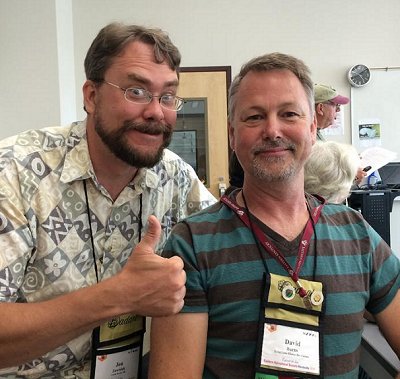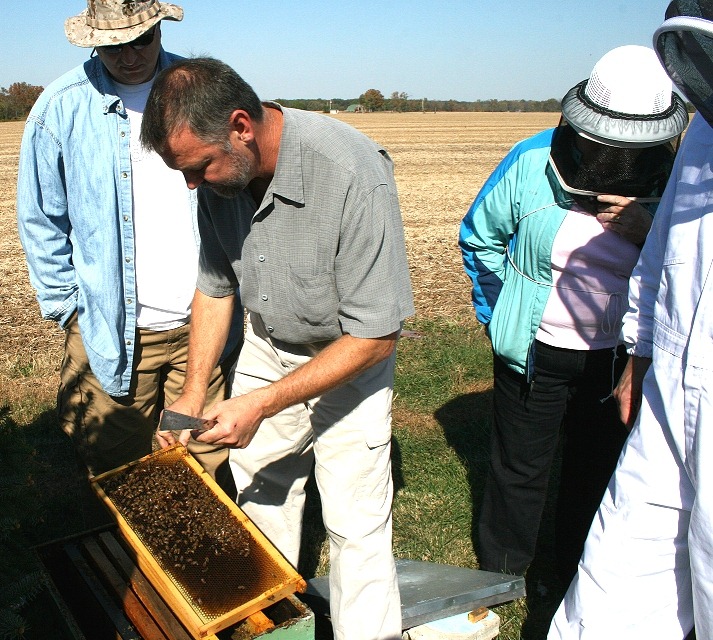Should You Feed 1:1 or 2:1 In The Fall?
|
|
 |
HIVE TALK is a beekeeping podcast with Jon Zawislak and David Burns. Join them today at 1:30 central time. They will be talking about why colonies become more defensive in the fall and steps to take to reduce stings during fall inspections.
Join two EAS certified master beekeepers and listen to them gab about stuff but mostly about bees. We need some of you to please call in and asks questions. You can make Hive Talk more interesting by calling in and asking questions live, or by logging in on your computer and texting us your question. Here’s how: The number to call is: 1-605-562-0444
When you call in you’ll be asked to enter our SHOW ID which is: 129777 followed by the # sign. Then the automated system will ask you for your Pin number which is 1 followed by the # sign. At that point, you’ll be on the show with us so you can ask your questions. So you don’t have to worry about keeping your kids or dogs quiet. You will be muted unless you press * 8 on your phone and that will allow us to unmute you so you can ask your question. Call in around 10 minutes prior to broadcast, at 1:30 p.m. central time. If you want to just listen from your computer, go to:
http://www.talkshoe.com/tc/129777Set your alarm and your smart phones.
If you missed us live, listen to the recorded episode on iTunes by
clicking here.
FREE WINTER BEE KIND
FOR NEW BEETEAM6 MEMBER SIGN UPS
Beekeeping Mentorship/Coaching Program
SEPTEMBER SIGN UP – Free Winter-Bee-Kind
David offers a mentoring/coaching program to beekeepers around the country. You can call, email or text your questions to David, an EAS Certified Master Beekeeper.
Plus, you receive a regular tip and video from David. Those who sign up in the month of September will receive one free Winter-Bee-Kind on your four month anniversary, in December. YOUR CHRISTMAS PRESENT! Free Shipping too! Click here to sign up now.
2:1 or 1:1 Which Is Best For Fall
The fall presents many challenges one of which is to know what to feed bees. Should it be? 1:1 or 2:1 sugar water. Traditionally, 2:1 (2 parts sugar and 1 part water) sugar water is given in the fall. However, this does not afford the colony the opportunity to build up brood. 2:1 is thicker enabling the bees to dry it faster in the fall for stored honey. 1:1 is much more beneficial because it enables the colony to continue to raise brood. Brood raised in the fall will be bees of winter physiology, meaning that they will live 4-6 months rather than 45 days in the summer. I, therefore, encourage you to do both 2:1 and 1:1.
Our Burns Bees Feeding System allows the beekeeper to feed both 1:1 and 2:1 and a pollen patty in the fall. This gives the bees added incentive to store honey, raise brood and to have the protein to do it all. Our
Winter-Bee-Kinds provide winter food.
TIP OF THE DAY: When to feed liquid sugar and when to feed a candy board: A colony will cluster when temperatures reach 50 degrees (f) or below. At this temperature bees will no longer consume liquid sugar water. My rule of thumb is that when bees are no longer flying due to colder temperatures it is best to place our winter-bee-kinds on top of your brood nest area. This allows the winter cluster to continue to have the added food as insurance. You’ve worked so hard to keep your colony healthy all year. So don’t let them starve this winter.
Getting Your Bees Through The Winter
Check out my two most recent videos on identifying brood patterns and how to know when your honey is capped over enough for harvest:
I’m glad you are keeping bees or thinking about it. Thank you for supporting our family business for all your beekeeping needs.
Sincerely,
David and Sheri Burns
Long Lane Honey Bee Farms
217-427-2678
New 2018 Store Location Hours:
Monday- Closed
Tuesday 10am – 2pm
Wednesday 10am – 2pm
Thursday 10am – 2pm
Friday 10am – 2pm
Saturday – 10am -2pm
Come visit us soon!
Źródło: Should You Feed 1:1 or 2:1 In The Fall?
Podobne wiadomosci:
Entrance Reducers, Fall Feeding, Robbing Prevention & Another New VideoThe Fall City Farmhouse Renovation by Nils FinneFeeding Bees In The Fall & Winter



